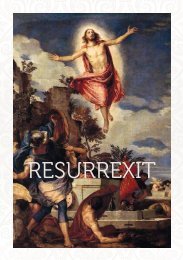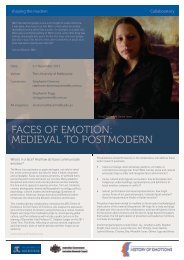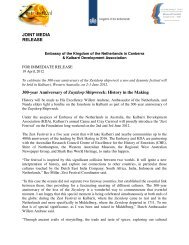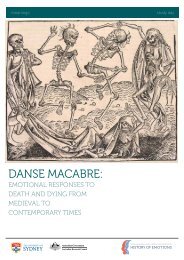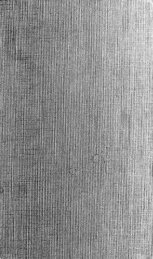Download our K-12 education pack - ARC Centre of Excellence for ...
Download our K-12 education pack - ARC Centre of Excellence for ...
Download our K-12 education pack - ARC Centre of Excellence for ...
You also want an ePaper? Increase the reach of your titles
YUMPU automatically turns print PDFs into web optimized ePapers that Google loves.
stories <strong>for</strong> teachers & students 2013<br />
Small Nation, Big Ambition<br />
At the dawn <strong>of</strong> the seventeenth century, the northern Dutch<br />
provinces found themselves in an unusual position. They had<br />
decided to break away from their anointed king, Philip II, and to<br />
lead themselves in government. This was an almost unheard-<strong>of</strong><br />
stance at the time. In 1556, Charles V had chosen to retire from<br />
his base in the Low Countries to live in much warmer Spain. His<br />
son Philip II remained there, governing the Netherlanders from<br />
faraway Madrid. This annoyed them: they felt Philip no longer<br />
had their interests at heart, especially as many people grew<br />
interested in the new Protestant faith to which both Charles and<br />
his son Philip were staunchly opposed. The northern provinces<br />
wanted the right to control their own affairs as well as to practise<br />
their faith as they saw fit. They <strong>for</strong>med a breakaway group called<br />
the United Provinces. William <strong>of</strong> Nassau, Prince <strong>of</strong> Orange, who<br />
had been raised Lutheran, converted to Catholicism, and then<br />
had become Calvinist, found himself the leader <strong>of</strong> the northern<br />
Dutch States. Philip did not take the break with these Protestant<br />
leaning northern provinces lightly. The Dutch and Spain entered<br />
years <strong>of</strong> bitter warfare, and William and then two <strong>of</strong> his sons,<br />
Maurice and Frederick Henry, became Dutch military leaders.<br />
William emerged as a sort <strong>of</strong> king in these new lands which soon<br />
became internationally famous <strong>for</strong> their religious tolerance and<br />
maritime endeav<strong>our</strong>s. The Dutch provinces realised that they<br />
needed the support <strong>of</strong> like-minded nations and states in Europe<br />
to survive, <strong>for</strong>ming new trade and social networks. However, they<br />
also recognised that their strength in maritime trade could<br />
extend beyond Europe, if it could be conducted in an organised<br />
fashion by the government.<br />
In 1602, the Vereenigde Oost-Indische Compagnie (VOC) was<br />
established as a chartered company granted rights by the Dutch<br />
States to exploit Asian trade, and in 1624, the Geoctroyeerde<br />
Westindische Compagnie (GWIC) was given rights to trade<br />
monopoly in the Caribbean, North America, Africa and Brazil.<br />
Even abroad, the role <strong>of</strong> William and his family in establishing<br />
the new Dutch nation was not <strong>for</strong>gotten. As sailors began to<br />
colonise the globe seeking <strong>for</strong>tune <strong>for</strong> the Dutch, they named<br />
ports, castles and <strong>for</strong>ts across the world in the Orange-Nassau<br />
family’s hon<strong>our</strong>: the island <strong>of</strong> Mauritius is named in hon<strong>our</strong> <strong>of</strong><br />
William’s son, Maurice, <strong>for</strong> example. The ships <strong>of</strong> the VOC flew<br />
the Prinsenvlag (the Prince’s flag) based on William’s livery <strong>of</strong><br />
orange, white and blue. However, orange dye was unstable and<br />
so the orange was changed to vermilion red which we still see in<br />
the Dutch flag today. Vermilion, a mineral pigment from<br />
cinnabar, was mined in China and very expensive. In the<br />
seventeenth century, a synthetic <strong>for</strong>m <strong>of</strong> mercuric sulfide was<br />
developed, known as ‘the Dutch method’. However, the col<strong>our</strong><br />
orange has remained important in varied ways. Today orange<br />
symbolises Protestantism and the Dutch worldwide as a result <strong>of</strong><br />
William and his family. Carrots are orange because <strong>of</strong> the Orange<br />
family too. In the seventeenth century, Dutch growers cultivated<br />
the variant orange-col<strong>our</strong>ed carrots as a tribute to William and<br />
the col<strong>our</strong> stuck. A thousand years <strong>of</strong> yellow, white and purple<br />
carrot history was wiped out in a generation.<br />
Supporting Res<strong>our</strong>ces<br />
Dutch Lives in the World<br />
stories by winthrop pr<strong>of</strong>essor susan broomhall<br />
FAR FROM HOME: ADVENTURES, TREKS, EXILES & MIGRATION<br />
53





